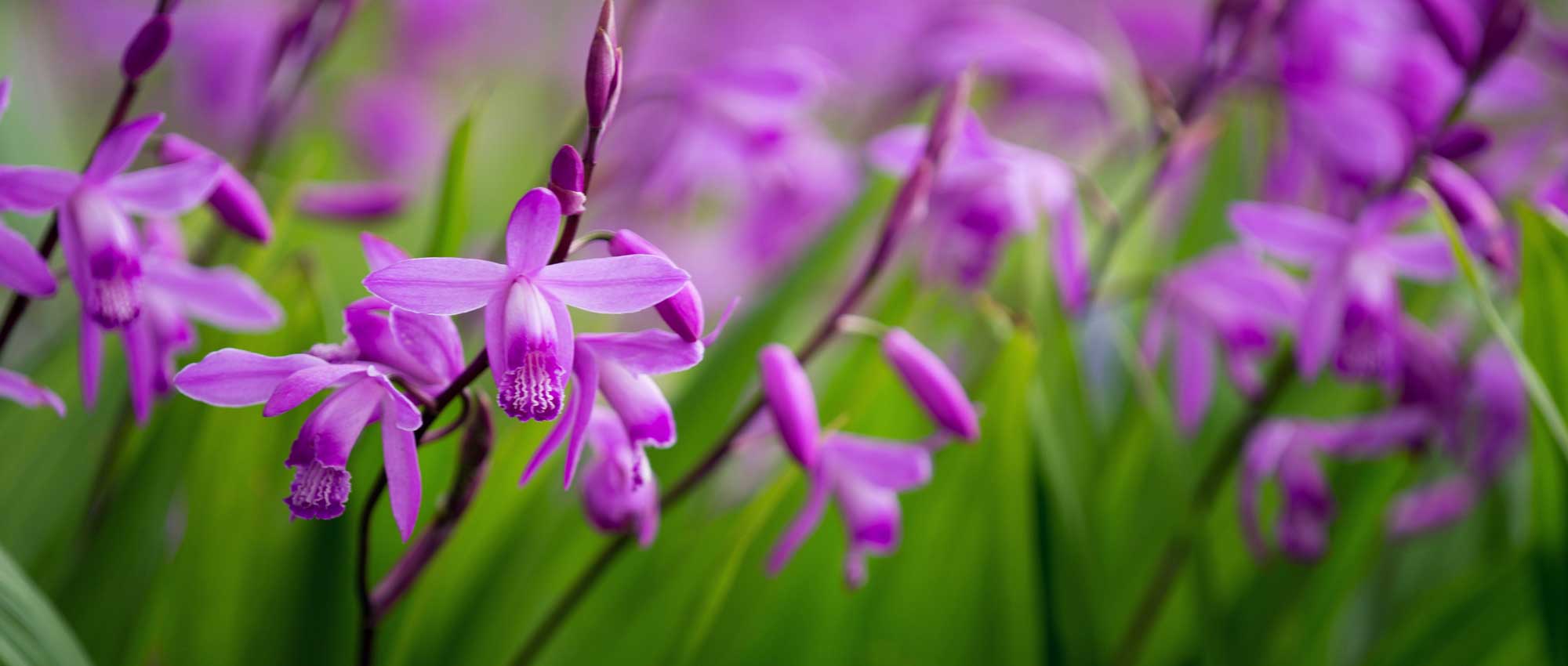
Bletilla, Chinese ground orchid: planting, growing and care
Contents
Bletillas in a nutshell
- Blétillas are the hardiest orchids that can be planted in the garden
- They produce stunning delicate and refined flowers in early summer, either pink-purple or white!
- They are perfect for adding a natural and wild or exotic touch to borders!
- Similar to that of a grass, the decorative foliage, elongated and plicate, is a beautiful bright green
- It is one of the easiest terrestrial orchids to grow in pots or borders!
A word from our Expert
Also known as Hyacinth Orchid or Japanese Orchid, Bletilla striata is a perennial plant of Asian origin that flowers in early summer. It is a terrestrial orchid that forms beautiful clumps of smooth, elongated leaves and offers a delicate flowering that is generally pink-purple. There are also varieties with white flowers, such as Bletilla ‘Alba’, blue flowers like Bletilla ‘Blue Dragon’, or pale pink like ‘Kuchibeni’. It is a prolific plant that has pseudo-bulbs, which allow it to spread. The Bletilla is in full growth in spring, then flowers at the end of spring or the beginning of summer, after which the aerial parts fade in autumn. It then enters dormancy for winter, reappearing in the following spring.
It is easy to assume that orchids are delicate plants that are difficult to grow… However, Bletilla is one of the easiest to succeed! Unlike tropical species, it can easily settle outdoors in the garden. It is also a plant that requires very little maintenance. It enjoys soil that remains cool in summer… but is particularly sensitive to excess water in winter! The bulbs could rot. Although it is relatively hardy, Bletilla may require protection in extreme cold. It multiplies easily by division of the rootstock.
Botany
Botanical data
- Latin name Bletilla striata
- Family Orchidaceae
- Common name Bletilla, Hyacinth Orchid, Chinese ground orchid
- Flowering between May and July
- Height between 30 and 50 cm
- Exposure partial shade
- Soil type very well-drained, cool in summer, fertile
- Hardiness -10 to -15 °C
The Bletillas are terrestrial orchids native to Asia that offer decorative flowering in early summer. They are perennial plants with deciduous foliage. There are five species, but the most commonly cultivated is Bletilla striata. Among the other species sometimes cultivated are Bletilla ochracea and Bletilla formosana… The Bletilla striata originates from China, Japan, and Tibet, where it mainly grows in mountainous areas. It can be found at the forest edge, in meadows, on rocky slopes, or near rivers. It was introduced to cultivation in Europe in the early 19th century.
The Bletilla belongs to the orchid family: Orchidaceae. This is a large, highly diverse family that includes between 25,000 and 28,000 species. They are monocotyledonous and herbaceous plants that can grow on land or on the trunks of other plants (epiphytes). Orchids are appreciated for the complex and refined appearance of their flowers.
The name Bletilla is a diminutive meaning “little Bletia,” with Bletia being another orchid with purple flowers. It was named in honour of Luis Blet, a Spanish apothecary from the 18th century. The species name striata means striped. It is also found under the Latin name Bletilla hyacinthina; in French, it is known as Hyacinth Orchid or Japanese Orchid.
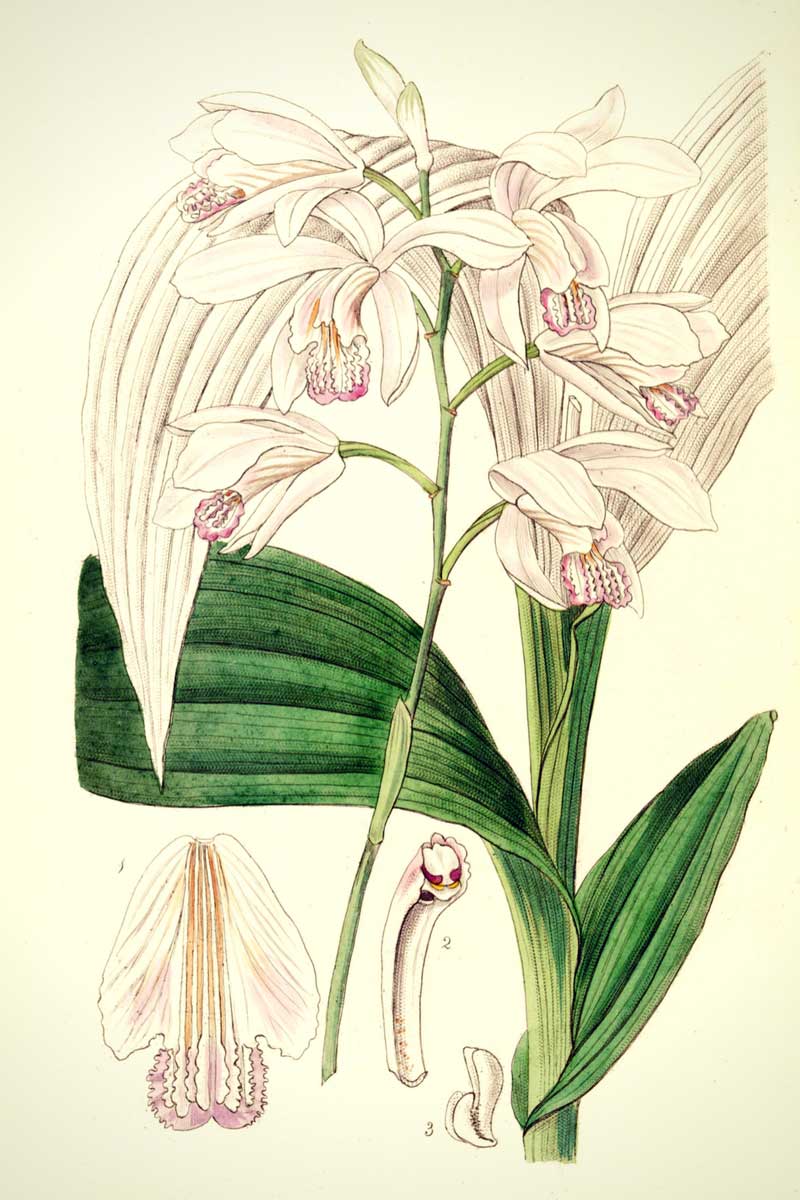
Bletilla striata: botanical illustration
The Bletillas form clumps of upright leaves. They measure between 30 and 50-60 cm in height and up to 50 cm in spread. They are prolific plants, and the clumps spread quite quickly. If the location suits it, the Bletilla can even naturalise.
Flowering occurs at the end of spring or the beginning of summer, between May and July. It lasts between three weeks and a month.
The plant then bears upright flower spikes, 30 to 40 cm high, which elevate the flowers above the foliage. They consist of eight to twelve flowers that open gradually: those at the bottom bloom before those at the top of the spike. The flowers of Bletillas resemble those of tropical species, which are sometimes cultivated indoors in our apartments. They may particularly remind one of Cattleyas. The flower stem is usually tinged with red-purple.
The flowers are most often pink-violet. They can also be white, as in Bletilla striata f. alba. There are also varieties with yellow flowers: Bletilla striata ‘Yellow’, and others with blue flowering: Bletilla striata ‘Soryu Blue Dragon’. The hue is rarely uniform; it features beautiful nuances, particularly due to the lip.
The Bletilla has a complex flower, typical of orchids. It measures three to six centimetres in diameter. The sepals and petals have the same appearance and colour. The flower consists of three well-developed outer sepals. They surround three petals, with the central one directed downwards and very developed: this is the lip. It serves as a landing strip for insects! It is also the most decorative part of the flower. It is tubular at the base, then opens to reveal stripes and ridges parallel to the crumpled appearance, usually white.

The flowering of Bletillas: the classic form of Bletilla striata (photo Claire H), Bletilla striata var. alba, and Bletilla ochracea (photo Stan Shebs)
The lip is often beautifully nuanced: in the classic form of Bletilla striata, it is striped white and bordered with deep pink-violet. In other varieties, it bears red or yellow markings. The lip is bright yellow, speckled with red, in Bletilla ochracea.
The Bletilla consists of several pseudobulbs, each bearing three to six upright leaves. The Bletillas have beautiful elongated and plicate leaves, measuring between 30 and 50 cm in length and 4-5 cm in width. They somewhat resemble those of gladioli but can also remind one of young palm leaves!
The leaves of Bletillas are medium green. However, some varieties have variegated foliage, striped white (Bletilla ‘Alba Variegata’) or yellow-cream (‘Gotemba Stripes’).
The foliage fades and disappears in autumn (around October), and the plant then enters dormancy: the aerial parts die, but it remains present underground in the form of pseudobulbs. The plant reappears in spring, starting in April. When it is dormant, it is important that the soil is well-drained; otherwise, the pseudobulbs may rot.

The foliage of Bletilla ochracea (photo Stan Shebs) and that of Bletilla striata (photo Magnus Manske)
The Bletillas have a short rhizome, from which flattened pseudobulbs develop, resembling corms. The rhizome extends by producing new buds and new adventitious roots… Bletillas can easily be multiplied by dividing the rhizomes.
The fruit of the Bletilla is an elongated capsule that opens when ripe to release the seeds. These are tiny, resembling dust. They need to associate with a microscopic fungus to germinate and develop, making sowing very delicate. Bletilla is usually multiplied by division.
The main varieties of Chinese ground orchids
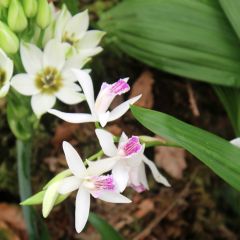
Bletilla striata alba - Chinese Ground Orchid
- Flowering time July, August
- Height at maturity 50 cm
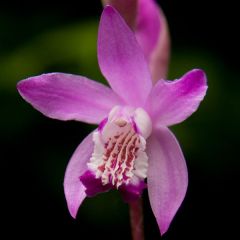
Bletilla striata Rose - Chinese Ground Orchid
- Flowering time July, August
- Height at maturity 50 cm
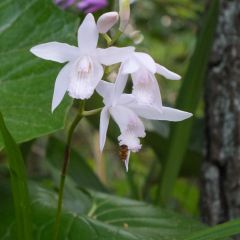
Bletilla striata f. gebina - Chinese Ground Orchid
- Flowering time June, July
- Height at maturity 40 cm

Bletilla striata Soryu Blue Dragon - Hyacinth orchid
- Flowering time June to August
- Height at maturity 45 cm
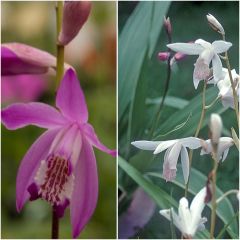
Collection of 6 Over-ripe Blétillas
- Flowering time July, August
- Height at maturity 50 cm
Discover other Bletillas or Hyacinth Orchids
View all →Available in 0 sizes
Available in 3 sizes
Available in 1 sizes
Available in 2 sizes
Available in 1 sizes
Available in 1 sizes
Available in 1 sizes
Available in 1 sizes
Available in 1 sizes
Available in 2 sizes
Planting the hyacinth orchid
Where to plant?
Plant the Bletilla orchids preferably in partial shade, although this varies depending on your geographical location: in the south and Mediterranean regions, it is better to protect them from the scorching sun. However, in the northern half of the country, you can certainly place them in full sun. The ideal situation for Bletillas is to have morning sun and dappled shade in the afternoon during the hottest hours (for example, with an east-facing exposure). Preferably choose a location sheltered from cold winds.
If you live in an area where winters are particularly cold, you can grow them in pots, so you can bring them under cover to protect them from frost in winter.
The Bletillas appreciates being planted in fertile soil, rich in humus. It also prefers neutral or slightly acidic soil, as it does not like calcareous substrates.
It is sometimes recommended to plant Bletillas at the edge of a pond so they can benefit from cool soil. However, it is essential that the soil does not remain constantly wet. Plant them in light, airy soil where water can easily drain away. They dislike waterlogged soils in winter, as excess moisture could cause the pseudo-bulbs to rot! You will need to improve drainage if your soil is heavy and clayey. However, Bletillas appreciate soils that remain cool in summer.
The Bletillas can easily fit into a flowerbed, but you can also isolate it to highlight it more, or plant it in a pot and place it on a terrace, a semi-shaded balcony, or in a patio. It can also find its place in a cool rock garden or in a woodland garden. The Bletilla is not an indoor plant: you can place it temporarily in a conservatory, but it needs cool temperatures in winter to bloom in spring!
When to plant?
Plant the Bletillas at the beginning of spring, around April.
How to plant?
Maintain a distance of about 20 cm between each plant.
- Dig a planting hole. If your soil is heavy and tends to retain water, add draining materials: gravel, coarse sand, pumice…
- Place a mixture of potting soil, compost, and sand in the planting hole, then install the pseudo-bulb. It should be placed 5 to 7 cm deep, with the buds facing upwards.
- Cover with a layer of substrate.
- Water.
- You can apply a mulch to keep the soil cool for longer and prevent weeds from growing.
Continue to water regularly after planting until the plant is established. Afterwards, you can space out the watering.
Pot planting:
The Bletilla adapts quite well to pot culture, as long as you plant it in draining substrate. The advantage is that if you live in a cold climate region, you can easily bring it into a cool but frost-free location for winter.
You can use a pot of about thirty centimetres in diameter, but avoid containers that are too large. Place a layer of gravel or broken pot at the bottom to allow water to drain more easily, then add potting soil mixed with a bit of coarse sand and heather soil. Arrange the pseudo-bulbs in the pot, cover with a thin layer of substrate, and water.
Care
Bletilla appreciates cool soils: water frequently in summer. The soil should not dry out too much during the growing season. However, excess moisture should be avoided, as it can cause the pseudobulbs to rot. Reduce watering in winter when the plant is in dormancy.
Although it is relatively hardy, Bletilla may require protection from frost. Its cold resistance also depends on the depth at which the bulb is buried. Sometimes, young shoots can be damaged by late frosts. We recommend protecting your Bletillas by applying a thick layer of mulch at their base in autumn. In addition to protecting them from frost, mulching will reduce the frequency of watering and weeding. If you live in an area where winters are particularly cold, and you have planted them in pots, temporarily bring them under frost-free shelter, but keep it cool, to take them out the following spring. If they are in the ground, you can also dig up the pseudobulbs to store them dry under frost-free shelter. Bletillas are not indoor plants: they need a relative period of cold in winter… heat could prevent the formation of flower buds! The ideal is to simply keep them frost-free.
It is best to remove flowers when they have faded. As Bletilla is a deciduous plant, the aerial parts dry out at the end of the growing season. You can tidy the clump by cutting the stems to five centimetres above the soil in autumn, around November.
Bletilla will appreciate a balanced slow-release fertiliser in early spring. If you are growing them in pots, occasionally apply liquid fertiliser with the watering water (possibly with a special orchid fertiliser).
In general, Bletillas grown in pots will be more sensitive to cold and will require more frequent watering and fertiliser applications than those in the ground. They need a bit more attention.
We recommend dividing Bletilla clumps every three to four years. This helps to regenerate them and improve flowering. If you are growing them in pots, repot them every two to three years, around February. The pseudobulbs tend to spread over time and move outward, while those in the centre of the clump die. Therefore, repot the plant by placing the clump back in the centre. Repot in a well-draining and airy substrate.
Bletilla is not very susceptible to diseases. The main cultivation problem you may encounter is excess moisture in winter, which causes the pseudobulbs to rot.
As for pests, slugs and snails enjoy nibbling on young shoots in spring. Bletillas can also be attacked by aphids. They settle on the leaves and suck the sap from the plant, which weakens it and often causes leaf distortion. You can treat with black soap. Bletillas are also susceptible to red spider mites and mealybugs. Red spider mites can sometimes cause yellowing of the foliage. You can combat them by spraying with water or nettle manure. Against mealybugs, use a mixture of black soap, water, and methylated spirits.
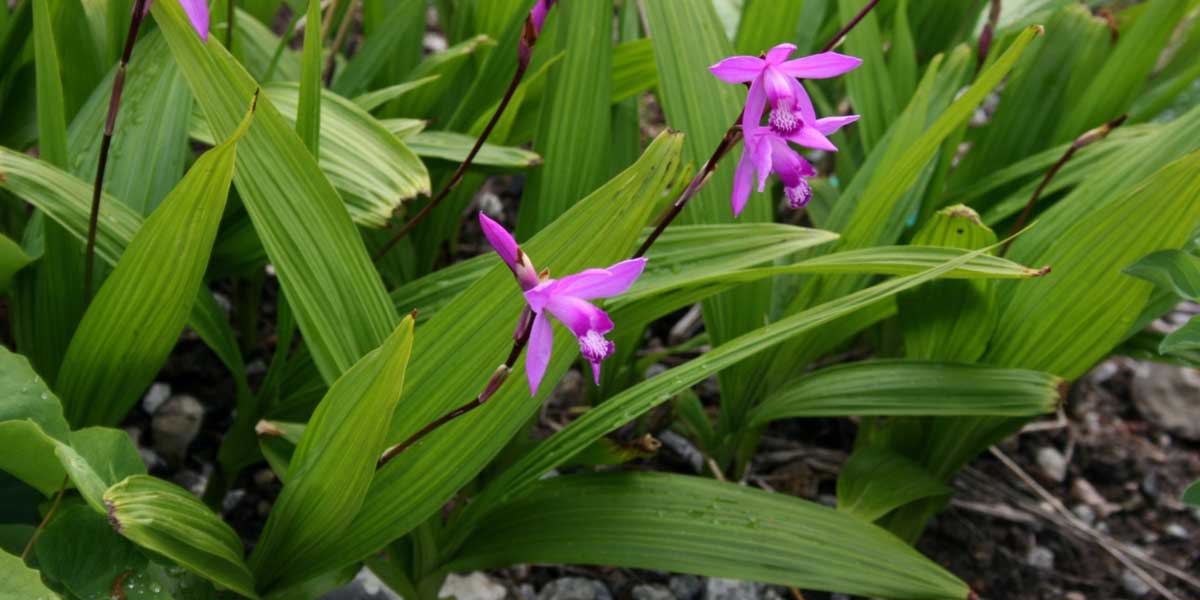
Propagation
Sowing orchids is generally quite complicated, but Bletillas can easily be multiplied by division!
Division
Don’t hesitate to multiply bletillas by division. We recommend doing this every three to four years. It’s best to intervene while the plant is still in growth, immediately after flowering.
- Dig up a rootstock. Preferably take one from the periphery, on the outside of the clump. You can remove the soil, possibly by rinsing the rootstock under water.
- Cut it cleanly with a knife.
- Prepare the ground and then replant the fragments.
- Water.
You can also divide the rootstocks of bletillas at the end of winter or at the beginning of spring (around March), before growth resumes.
Association
Bletillas can certainly find their place in a mixed border, alongside other colourful blooms and decorative foliage. However, we recommend favouring plants with soft and delicate hues (pale pink, white, blue, mauve…). You can pair them with gypsophila, roses, or hardy geraniums… You can position the bletillas at the edge of a flowerbed, in front of larger plants.
Enjoy the delicate flowering of bletillas to create a very natural garden, reminiscent of a woodland garden: combine them with the decorative foliage of hostas, ferns, or brunneras… Also discover the light flowers of epimediums! Add some Arisaema and Solomon’s seals. You can also include comfrey (Symphytum officinale) or sweet woodruff… Your garden will have the feel of a true natural forest, perhaps with a bit more bloom! Place these plants under trees or bushes with light foliage, not too dense, as bletilla appreciates good light!

For a woodland garden, with a very natural style: Bletilla striata (photo David J. Stang), Paris polyphylla, Arisaema ciliatum, and Hosta ‘Emily Dickinson’
It is sometimes advised to plant bletillas near a pond. This idea is perfect for creating a very natural and wild garden. But be cautious… while it is true that bletillas enjoy coolness, they fear excess moisture and require well-draining soil. If you place them a bit apart, on a mound or in well-draining ground, you can create a beautiful scene by pairing them with gunneras, ferns, or Asian primroses!
To continue enjoying a natural and wild-style garden, you can plant bletilla with other orchids: Lady’s slipper (Cypripedium calceolus), Calanthe, Pleione, Dactylorhiza… These plants are quite rare in gardens, yet they all offer delicate and refined blooms! In the same spirit, you can pair bletillas with rare bulbs.
Don’t hesitate to isolate a few clumps of bletillas to highlight them. They can bring a touch of nature to a more controlled, linear environment… If your garden has a rather formal, modern look, with straight lines and perfectly trimmed plants, you can plant bletillas to provide contrast, a more natural and wild aspect. Scatter a few clumps here and there, for example, along the edge of a short grass meadow…
Did you know?
- A medicinal plant
The rootstock of Blétilla is sometimes used in herbal medicine in traditional Chinese medicine. It is said to be effective against tuberculosis, lung diseases, and may help stop bleeding and relieve burns.
Useful resources
- Discover our range of over-ripe orchids!
- To pair with over-ripe orchids, discover our collection of rare bulbs!
- Discover the hardy orchids to grow in the garden!
- Feel free to check our complete guides to grow Calanthes, Cypripediums, Pleiones and Dactylorhiza
Frequently asked questions
-
The flowering of my Bletilla seems to be dwindling, becoming weaker and weaker... What should I do?
We advise you to divide the clumps every three to four years. This will help to regenerate them and promote a beautiful flowering. It is also preferable to make some fertiliser applications, particularly at the beginning of spring. You can add a little liquid fertiliser to the watering water. If you are growing it in a pot, remember to repot it from time to time (on average every two years). Finally, the bletillas need to be kept cool in winter to produce flower buds... You can protect them from the cold by bringing them indoors for the winter, but be careful not to place them in a spot that is too warm!
-
The leaves of my Bletillas are turning yellow! Why?
This may be due to aphids, which can sometimes cause yellowing and deformation of the leaf. Treat by spraying a solution based on black soap. Similarly, red spider mites can attack the Bletillas and cause their leaves to yellow. The Bletilla is one that enjoys partial shade... if exposed to too much light, under scorching sun, the foliage may tend to yellow. It can also happen that excess moisture causes the foliage to yellow... be sure to grow the Bletilla in well-draining soil, and reduce watering in winter!
- Subscribe!
- Contents
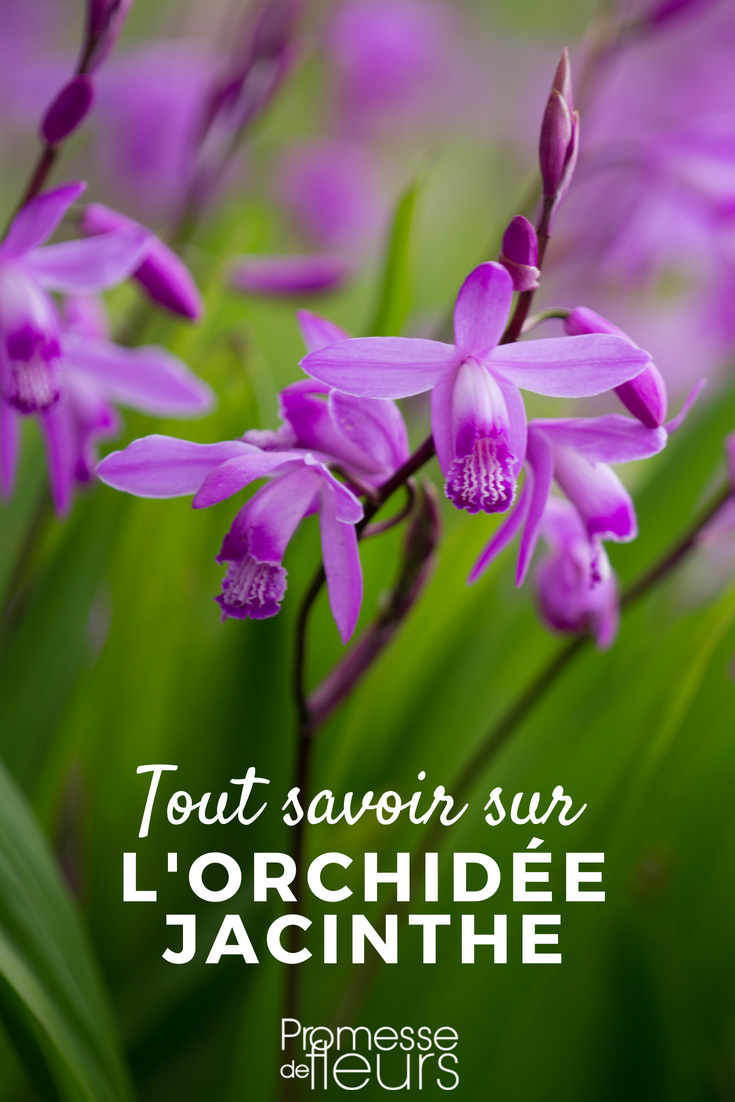

































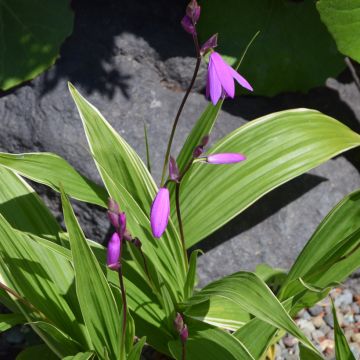

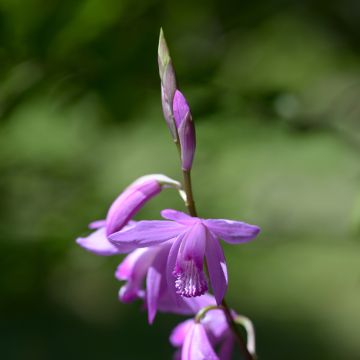
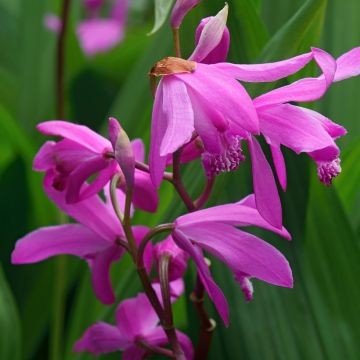
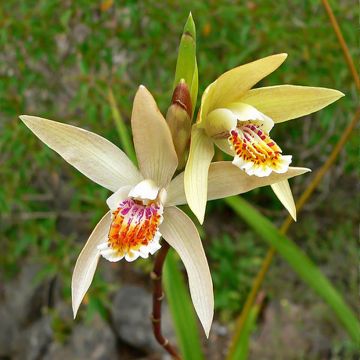

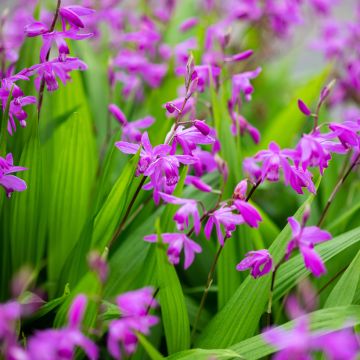
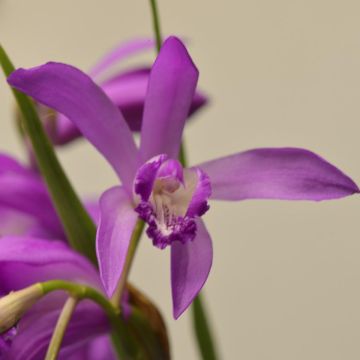
Comments